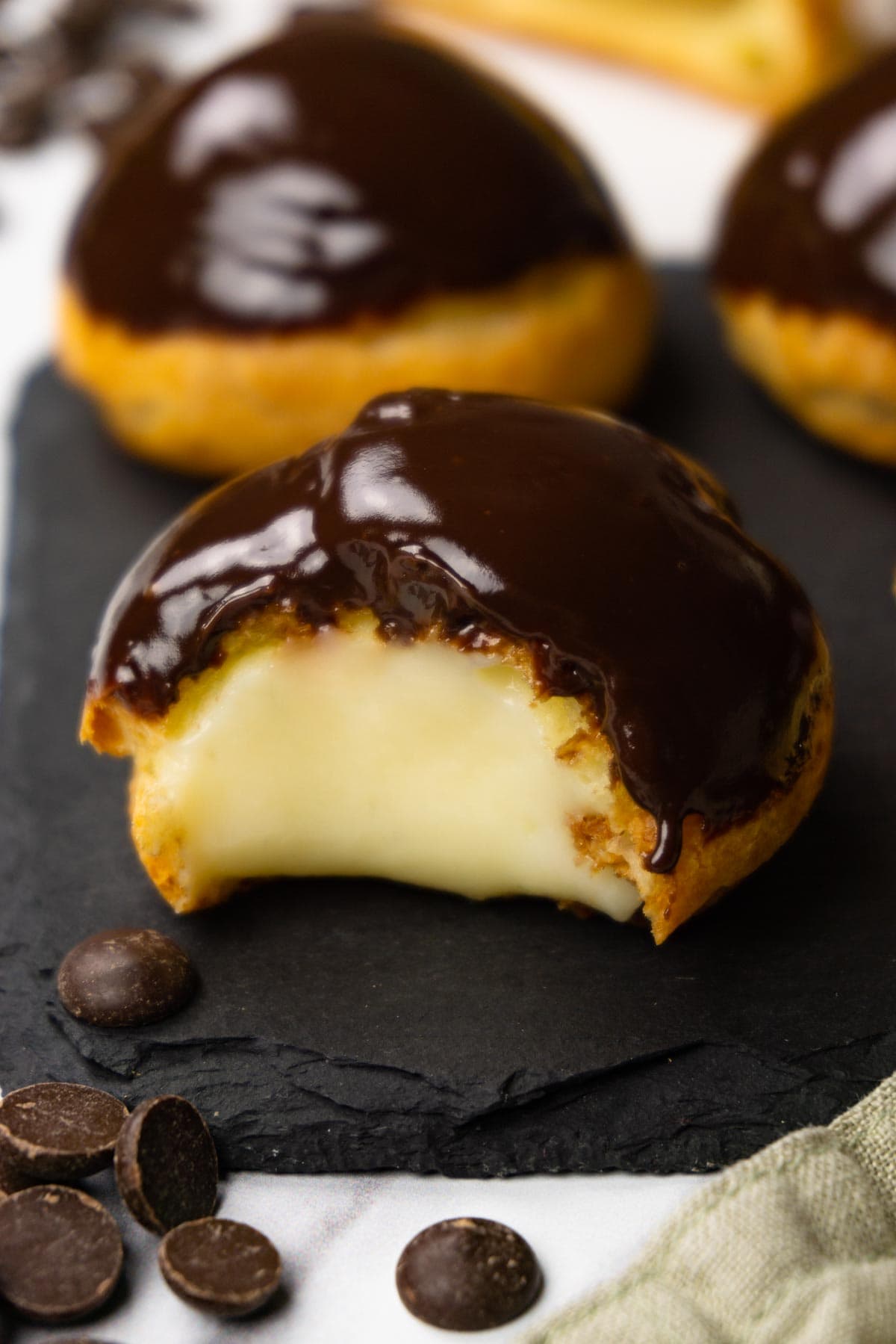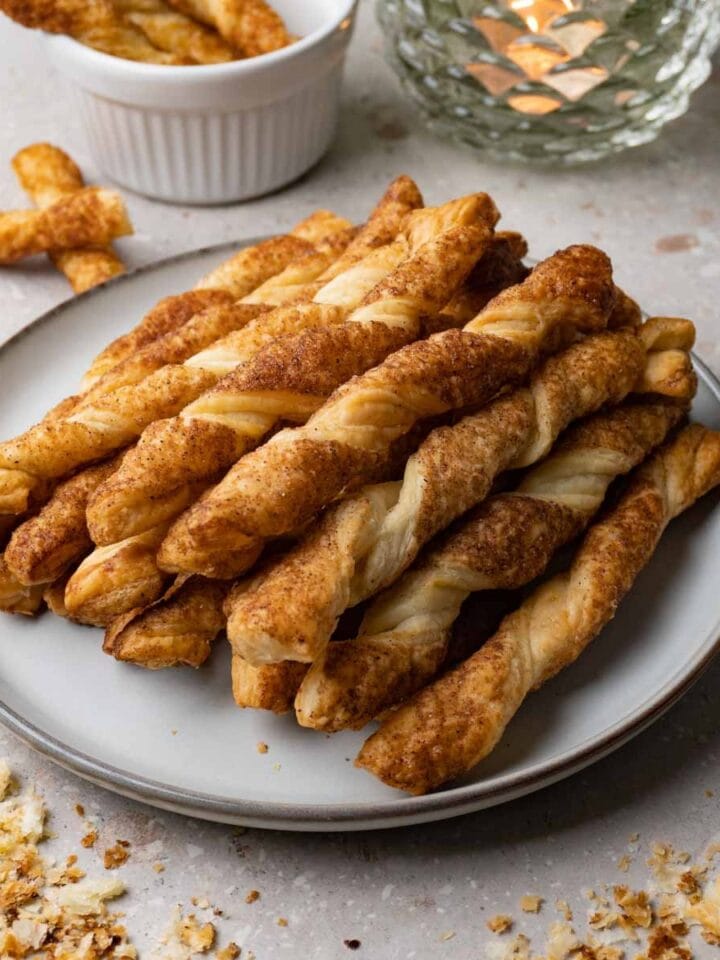Light and flavorful, this choux pastry will be a great base for so many desserts such as cream puffs, profiteroles, and eclairs.

Jump to:
What is choux pastry?
Choux pastry, also known as pâte à choux, is a versatile French pastry dough known for its light, airy texture and ability to puff up during baking. It's made by cooking together water (or a mix of water and milk), butter, salt, sugar, and flour until it forms a thick paste, then incorporating eggs to create a smooth, elastic dough. The high moisture content of the dough creates steam during baking, causing the pastry to expand, creating hollow centers that can be filled with sweet or savory fillings. Choux pastry is used to make a variety of delicious treats, including Cream puffs, eclairs, Profiteroles, churros, and even cakes such as this Karpatka.
Looking for more delicious pastry recipes? Then, you may like this Apple Tarte Tatin, Apple turnover recipe, or this Cream cheese Danish.
Ingredients you will need
Milk and water – Some choux pastry recipes call for only water, resulting in a crispier texture, while others use milk for softer pastry shells. I prefer to use a 50/50 mix of water and whole milk when I make choux pastry.
Salt and sugar – Salt and sugar are essential in this dough not only for flavor but also for affecting the emulsification and browning of the dough.
Butter – You will need unsalted butter to make choux pastry dough.
Eggs – Beat the eggs lightly before adding them to the dough.

Cooking tips
Weigh all ingredients using a digital kitchen scale. This choux pastry dough recipe needs precision to turn out correctly.
Cool down the dough before adding the eggs to it. Allowing the dough to cool slightly after cooking helps prevent the eggs from scrambling when mixed in.
Press down all the pointy tails on top of each round. When making choux pastry, gently pressing down the pointy tails with a damp finger or brush creates a smoother surface, making them expand evenly during baking.
How to make choux pastry
- In a saucepan, combine the milk, water, butter, salt, and sugar. Heat over medium heat until the mixture starts boiling. Remove from the heat and add the flour all at once. Mix with a rubber spatula until no dry ingredients are left.
- Bring back to the heat and cook the dough for 2 minutes, mixing continuously with the rubber spatula until a whiteish film forms on the bottom of the pan and the dough forms a ball with a homogeneous consistency. Remove from the heat.

- Place the dough in a stand mixer fitted with a paddle attachment (you can also use a bowl and a rubber spatula or spoon). Beat the dough on low for a minute or until it’s not quite hot to the touch but still warm.
- Gradually add the eggs, beating on medium speed until fully incorporated. The dough should be smooth and when you lift the paddle, it should slowly fall from it leaving a V-shaped tail.

- Transfer the dough into a piping bag fitted with a round nozzle and pipe 30 even 1 ½" or 4cm rounds.
- Dampen your finger with water and press down all the pointy tails on top of each round.
- Bake one batch at a time at 375F (190C) for 25-30 min, or until puffed up, golden brown, and crispy.
- Remove from the oven and let cool down on the baking sheet for 10 minutes, then place on a cooling rack to cool down completely. Pipe the second batch and bake.

Troubleshooting
Your pastries are too soft after baking
This could be due to underbaking. Make sure your pastries are baked until golden brown and crisp. Additionally, allow them to cool completely on a wire rack to firm up.
Another reason could be that you added too many eggs to your dough, (Read the 'The dough is too runny' section below.)
Pate choux collapses after baking
Opening the oven door too soon or baking at a lower temperature during baking can cause the pastries to collapse.
The dough is too runny
If your dough is too runny, it may be due to adding too much liquid, or not cooking the flour mixture long enough on the stovetop, or adding too many eggs in the last step of the preparation. Pastries that are made with runny dough tend to bake flat, with a soft and somewhat soggy texture.
Unfortunately, adding extra flour to thicken your dough will make things worse, so you will have to start from scratch. The only way to fix runny dough is to cook extra dough without adding eggs to it (¼-1/3 of a batch should be enough) and add a little bit of it at a time to your previous batch until it reaches the right consistency.
The dough is too thick
If the dough is too thick, it may have been cooked for too long, or not enough liquid or eggs were added. Adjust the cooking time or add a little extra eggs gradually until the dough reaches the desired consistency.

FAQ
Yes, you can store choux pastry in a closed piping bag in the fridge for 1-2 days.
Choux pastry should generally not be frozen before baking because it can affect its texture and ability to rise properly during baking.
Unfilled choux pastry shells can be stored in an air-tight container at room temperature for 1-2 days. They will soften during storage time. If you want to make them crisp again, you will need to bake them for a couple of minutes at 375F (190C).
Filled with cream, the choux pastry should be stored in an air-tight container in the fridge for up to 4 days.
Yes, you can freeze them for up to 2 months. Thaw in the fridge overnight and bake for a couple of minutes at 375F 190C before filling with cream.
More recipes you may like
Easy homemade chocolate truffles
Recipe card

Choux pastry
Equipment
- Digital kitchen scale
- Saucepan
- Stand mixer or hand mixer and a large mixing bowl a wooden spoon or a spatula will work as well
- Piping bags
- Round piping nozzle
- Parchment paper
Ingredients
- 75 ml whole milk
- 75 ml water
- 75 g unsalted butter
- 2 teaspoon granulated sugar
- ½ teaspoon salt
- 100 g all-purpose flour
- 170 g eggs 3 large eggs (slightly beaten in a bowl)
Instructions
- In a saucepan, combine the milk, water, butter, salt, and sugar. Heat over medium heat until the mixture starts boiling. Remove from the heat and add the flour all at once. Mix with a rubber spatula until no dry ingredients are left.
- Bring back to the heat and cook the dough for 2 minutes, mixing continuously with the rubber spatula until a whiteish film forms on the bottom of the pan and the dough forms a ball with a homogeneous consistency. Remove from the heat.
- Place the dough in a stand mixer fitted with a paddle attachment (you can also use a bowl and a rubber spatula or spoon). Beat the dough on low for a minute or until it’s not quite hot to the touch but still warm (the ideal temperature should be 110F-140F or 43C-60C ).
- Gradually add the eggs, beating on medium speed until fully incorporated. Scrape the sides and the bottom of the bowl and beat one last time just for a few seconds to mix. The dough should be smooth and when you lift the paddle, it should slowly fall from it leaving a V-shaped tail. It should be firm enough to hold a shape when piped out but moist. If this texture is achieved before all eggs are incorporated, stop adding them. If the texture is not there yet after you’ve added all the eggs, you need to add ¼ - 1 extra egg.
- Transfer the dough into a piping bag fitted with a round nozzle (such as Wilton 2A). Keep the piping nozzle facing straight down toward the piping surface (0.5” or 1 cm away from it) and pipe 30 even 1 ½" or 4cm rounds. Apply an even pressure, letting the rounds expand a little bit up and sideways. Leave 1" in between them. Work in batches if needed. The dough can wait in the piping bag while the first batch is in the oven. Dampen your finger with water and press down all the pointy tails on top of each round.
- Bake one batch at a time at 375F (190C) for 25-30 min, or until puffed up, golden brown, and crispy. The baking time will vary on the size of your pastries. Baking eclairs can take up to 40 min.
- Remove from the oven and let cool down on the baking sheet for 10 minutes, then place on a cooling rack to cool down completely. Pipe the second batch and bake.





Leave a comment